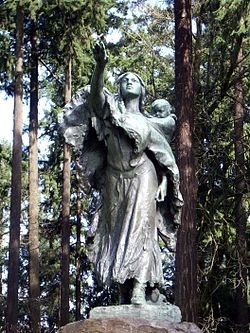Alice Cooper (sculptor)
Alice Cooper | |
|---|---|
| Born | April 8, 1875 |
| Died | March 4, 1937 (aged 62) |
| Nationality | American |
| Known for | Sculpture |

Alice Cooper (April 8, 1875 – March 4, 1937) was an American sculptor.
Early life and education
Cooper was born in Glenwood, Iowa and was raised in Denver, Colorado.[1]
She studied under Preston Powers (son of the sculptor Hiram Powers[2]) then at the Art Institute of Chicago with Lorado Taft and the Art Students League of New York through about 1901.
Career
Cooper is best known for her bronze figure of Sacajawea (Sacajawea and Jean-Baptiste) originally produced as the centerpiece for the Lewis and Clark Centennial Exposition in Portland, Oregon, 1905, unveiled in a ceremony attended by Susan B. Anthony and other prominent feminists.[3] This figure now stands in Washington Park.
Other work includes:
- Bronze figure of Almeron Eager of Evansville, Wisconsin, 1907
- Work produced for the United States Customs House in San Francisco, California, for architects Eames and Young, circa 1911
She displayed work at her alma mater, Art Institute of Chicago, as well as the Pennsylvania Academy of Fine Arts and the National Academy of Design.[1] Some of her works were sold by Tiffany & Co.[1]
Personal life
Cooper resided in Denver, Colorado, as well as Illinois and Iowa.[1] In 1905 she married Nathan M. Hubbard and moved to Des Moines, Iowa.[1] They had three daughters.[1]
She died on March 4, 1937 in Chicago,[1] Illinois, at age 62.
References
- ^ a b c d e f g Kovinick, Phil; Yoshiki-Kovinick, Marian (eds.). Alice Cooper. Retrieved January 12, 2018 – via askart.com.
{{cite encyclopedia}}:|work=ignored (help) - ^ Crane, Sylvia E. (1972). White Silence: Greenough, Powers and Crawford, American Sculptors in Nineteenth Century Italy. University of Miami Press. p. 266. ISBN 9780870241994.
- ^ Fresonke, Kris; Spence, Mark David, eds. (2004). Lewis & Clark: Legacies, Memories, and New Perspectives. University of California Press. p. 202. ISBN 9780520228399. Retrieved January 12, 2018 – via Google Books.
- American women sculptors
- Art Students League of New York alumni
- 1875 births
- 1937 deaths
- People from Glenwood, Iowa
- Artists from Denver
- Sculptors from Iowa
- School of the Art Institute of Chicago alumni
- 20th-century American sculptors
- 20th-century American women artists
- Sculptors from New York (state)
- Sculptors from Colorado
- American sculptor stubs
